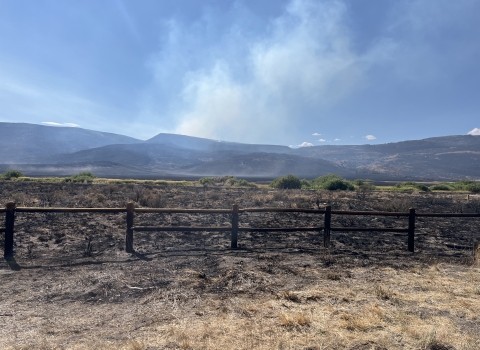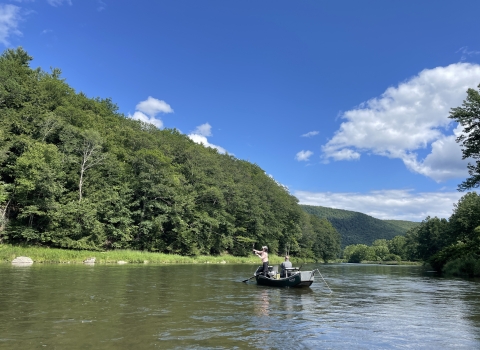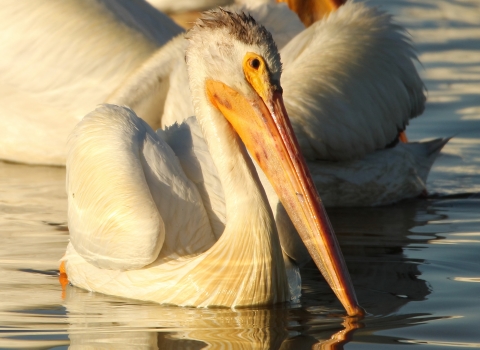Partners have reached a milestone in the relicensing process for two hydropower facilities on the Connecticut River in Massachusetts.
The U.S. Fish and Wildlife Service, NOAA Fisheries, the Massachusetts Division of Fisheries and Wildlife, The Nature Conservancy, and FirstLight Power filed a settlement agreement with the Federal Energy Regulatory Commission (FERC) for the Northfield Mountain Pumped Storage and Turners Falls Projects.
The result of years of collaboration among state, federal, and nongovernmental conservation partners to advocate for the needs of fish and wildlife, the settlement agreement is expected to result in numerous benefits for migratory fish and other federally and state-protected species that rely on the river.
“This agreement represents a major step forward in restoring sustainable migratory fish populations and recreational fishing in the Connecticut River,” said Rick Jacobson, Assistant Regional Director for the Service’s Fish and Aquatic Conservation Program. “Thanks to the work of many partners, we were able to come together on an agreement that will help conserve some of our most iconic and imperiled species.”
Expected benefits include:
Vastly improved fish passage fish passage
Fish passage is the ability of fish or other aquatic species to move freely throughout their life to find food, reproduce, and complete their natural migration cycles. Millions of barriers to fish passage across the country are fragmenting habitat and leading to species declines. The U.S. Fish and Wildlife Service's National Fish Passage Program is working to reconnect watersheds to benefit both wildlife and people.
Learn more about fish passage and fish protection measures
New fish passage standards, with evaluations and responsive management approaches to ensure all new/improved fish-passage facilities are effective
Restoring more naturalized flow to over 20 miles of the Connecticut River, which will enhance the quantity and persistence of habitat for fish and a suite of rare species — including the cobblestone tiger beetle, Puritan tiger beetle, yellow lampmussel, eastern pondmussel, and tidewater mucket — as well as 17 species of state-listed dragonflies and plants
Improved spawning and rearing habitat for shortnose sturgeon, American shad, and sea lamprey
Creating two mitigation funds to compensate for unavoidable impacts to cobblestone tiger beetle habitat at Turners Falls and loss of eggs and juvenile American Shad at the Northfield Mountain Pump Storage facility
The Service and partners have participated in settlement discussions since 2012, a process that allows parties with competing interests to reach agreement before FERC initiates its environmental review.
The discussions created opportunities to proactively address potential issues, including reducing operational impacts to listed and priority species, developing and proposing mitigation measures for unavoidable impacts, and creating value-added provisions that fall outside agencies’ statutory authorities.
“NOAA Fisheries is grateful for the hard work and dedication of all the partners involved in this settlement agreement,” said Mike Pentony, Regional Administrator for the Greater Atlantic Regional Fisheries Office. “This agreement improves the recovery potential for shortnose sturgeon, while providing long-lasting benefits for American shad and other sea-run fish.”
“This settlement agreement will improve the overall health of the Connecticut River ecosystem, benefiting both people and wildlife," said Mark. S. Tisa, Director of the Massachusetts Division of Fisheries and Wildlife. "Restoring higher minimum flows and more natural hydrology to over 25 miles of the Connecticut River will improve local fish and wildlife habitats, protect rare species, and enhance recreational fishing opportunities."
“On the Connecticut River, we’ve demonstrated that solutions are possible, recognizing that while hydropower can be an important energy source, it has impacts on river ecosystems,” said Katie Kennedy, Applied River Scientist with The Nature Conservancy. “We’ve brought the best science to bear – and a lot of sweat and tears – to ensure both tangible benefits for the river ecosystem and continued stability for the region’s energy grid.”
"FirstLight is proud to support this foundational settlement Agreement, the product of nearly a decade of collaboration and study to establish science-based measures to improve fish passage, aquatic habitat, and overall river health while enhancing whitewater recreation access and maintaining our ability to provide clean power to the region," said Justin Trudell, Chief Operating Officer of FirstLight Power. "We are grateful for the advocacy, expertise, and true dedication shown by our partners in this process and look forward to implementing these commitments and delivering on our collective vision of a thriving Connecticut River."
The Service uses authorities granted by the Federal Power Act, the Endangered Species Act, and the Fish and Wildlife Coordination Act to advocate for benefits for fish and wildlife resources in the public trust and to minimize impacts to them, including migratory fish and federally protected species. Together, these statutes have been highly effective at saving listed species from extinction, conserving declining species, and keeping common species common.
While the Service does not have the authority to determine whether a facility receives a FERC license or to decide how energy is produced or used at facilities, the agency can influence and prescribe how some aspects of a facility may operate within the context of any license issued by FERC, relative to resource impacts based on authorities and law.
The agreement is available on FERC's website at https://elibrary.ferc.gov/eLibrary/filelist?accession_num=20230331-5600



